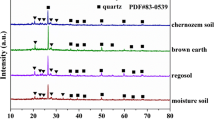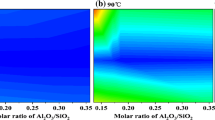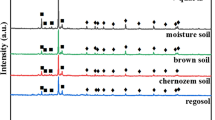Abstract
The proper disposal of radioactively contaminated soil during the process of nuclear energy application has become the focus of attention. In this work, simulation Sr-contaminated soils could were successfully vitrified by microwave sintering. XRD and FESEM results show that the matrix has excellent glass morphology. The highest Vickers hardness and density values are 8.0 GPa and 3.10 g·cm−3. The NRSr after 14 days is less than 7.9 × 10–4 g·m−2·d−1, which shows the excellent chemical durability of glass. FT-IR and MD simulation results show that the matrix consists of [AlO4] and [SiO4].
Graphical abstract









Similar content being viewed by others
References
Chen Y, Martin G, Chabert C, Eschbach R, He H, Ye GA (2018) Prospects in China for nuclear development up to 2050. Prog Nucl Energ 103:81–90
He G, Mol A, Lei Z, Lu Y (2014) Nuclear power in China after Fukushima: understanding public knowledge, attitudes, and trust. J Risk Res 17:435–451
Dai J, Li S, Bi J, Ma Z (2019) The health risk-benefit feasibility of nuclear power development. J Clean Prod 224:198–206
Maxi C, Núria C, Crystaline F, Breier SM, Pike P, Masqué, (2016) Reassessment of (90)Sr, (137)Cs, and (134)Cs in the coast off Japan derived from the Fukushima Dai-ichi nuclear accident. Environ Sci Technol 50:173–180
Natarajan V, Karunanidhi M, Raja B (2020) A critical review on radioactive waste management through biological techniques. Environ Sci Pollut R 27:29812–29823
Groudev SN, Georgiev PS, Spasova II, Komnitsas K (2001) Bioremediation of a soil contaminated with radioactive elements. Hydrometallurgy 59:311–318
Tamaoki M, Yabe T, Furukawa J, Watanabe M, Ikeda K, Yasutani I, Nishizawa T (2016) Comparison of potentials of higher plants for phytoremediation of radioactive cesium from contaminated soil. Environ Control Biol 54:65–69
He L, Wang Z, Gu WB (2020) Evolution of freeze–thaw properties of cement–lime solidified contaminated soil. Environ Technol Inno 21:101189
Li JS, Chen L, Zhan B, Wang L, Tsang DCW (2021) Sustainable stabilization/solidification of arsenic-containing soil by blast slag and cement blends. Chemosphere 271:129868
Wang F, Zhang Y, Shen Z, Pan H, Xu J, Al-Tabbaa A (2019) GMCs stabilized/solidified Pb/Zn contaminated soil under different curing temperature: physical and microstructural properties - ScienceDirect. Chemosphere 239:124738–124738
Zhang S, Shu XY, Chen SZ, Yang HM, Hou CX, Mao XL, Chi FT, Song MX, Lu XR (2017) Rapid immobilization of simulated radioactive soil waste by microwave sintering. J Hazard Mater 337:20
Lee HY, Tseng KH, Wang CH, Lin CC, Jou CJG (2014) Efficient microwave technology to immobilize heavy metal copper (Cu) contaminated soil by microwave energy. Pract Period Hazard Toxic Radioact Waste Manag 14:21–24
Wang BB (2013) Study on microwave vitrification technology of heavy metal contaminated soil. Environ Eng 31:96–98
Jou CJ (2006) An efficient technology to treat heavy metal-lead-contaminated soil by microwave radiation. J Environ Manage 78:1–4
Shu XY, Li YP, Huang WX, Chen SZ, Xu C, Zhang S, Li BS, Wang Y, Wang XQ, Qing Q, Lu XR (2020) Solubility of Nd3+ and Ce4+ in co-doped simulated radioactive contaminated soil after microwave vitrification. Ceram Int 46:6767–6773
Chen SZ, Shu XY, Tang HX, Mao XL, Lu XR (2019) Microwave vitrification of uranium-contaminated soil for nuclear test site and chemical stability. Ceram Int 45:13334–13339
Shu XY, Huang WX, Shi KY, Chen SZ, Lu XR (2021) Microwave vitrification of simulated radioactively contaminated soil: mechanism and performance. J Solid State Chem 293:121757
Gale JD, Rohl AL (2003) The general utility lattice program (GULP). Mol Simul 29:291–341
Wang M, Krishnan NMA, Wang B, Smedskjaer MM, Mauro CJ, Bauchy M (2018) A new transferable interatomic potential for molecular dynamics simulations of borosilicate glasses. J Non-cryst Solids 498:294–304
Guillot B, Sator N (2007) A computer simulation study of natural silicate melts. Part II: high pressure properties. Geochim Cosmochim Ac 71:4538–4556
Xiang Y, Du J (2011) Effect of strontium substitution on the structure of 45S5 bioglasses. Chem Mater 23:2703–2717
Kim TE, Park JM, Sohn SW, Kim DH, Kim WT, Stoica M, Kü HU, Eckert J (2010) Effect of carbon addition on the microstructural evolution and mechanical properties in hypo-eutectic Fe-Zr(-Nb) alloys. Mater Trans 51:799–802
Kaur P, Kaur S, Singh GP, Singh DP (2014) Cerium and samarium co-doped lithium aluminoborate glasses for white light emitting devices. J Alloy Compd 588:394–398
Mitang W, Jinshu C, Mei Li, Feng He (2011) Structure and properties of soda lime silicate glass doped with rare earth. Physica B 406:187–191
Peng LU, Xia WB, Jiang H, Zhao HF (2015) Analysis of high alumina silicate glass with infrared and Raman spectroscopy. Bull Chin Ceram Soc 34:878–881
Stuart BH (2004) Infrared spectroscopy: fundamentals and applications. Exp Thermodyn 41:325–385
Etchepare J (1970) Interprétation des spectres de diffusion Raman de verres de silice binaires. Spectrochim Acta A 26:2147–2154
McMillan P (1984) Structural studies of silicate glasses and melts; applications and limitations of Raman spectroscopy? Am Mineral 69:622–644
Nakamoto K (1970) Infrared and Raman spectra of inorganic and coordination compounds. Theory Appl Inorg Chem 88–97
Rosales-Sosa GA, Masuno A, Higo Y, Inoue H (2016) Crack-resistant Al2O3–SiO2 glasses. Sci Rep-UK 6:23620
Weber WJ, Matzke H, Routbort JL (1984) Indentation testing of nuclear-waste glasses. J Mater Sci 19:2533–2545
Connelly AJ, Hand RJ, Bingham PA, Hyatt NC (2011) Mechanical properties of nuclear waste glasses. J Nucl Mater 408:188–193
Cailleteau C, Weigel C, Ledieu A, Barboux P, Devreux F (2008) On the effect of glass composition in the dissolution of glasses by water. J Non-cryst Solids 354:117–123
Ledieu A, Devreux F, Barboux P, Sicard L, Spalla O (2004) Leaching of borosilicate glasses. I. Experiments. J Non-cryst Solids 343:3–12
Zhang RZ, Gao YW, Wang JS, Li L, Su WS (2011) Leaching properties of immobilization of HLW into SrTiO3 ceramics. Adv Mater Res 332–334:1807–1811
Zhang RZ, Guo ZM (2004) Solidification of radiocative waste with Sr2+ perovskite synrock SHS mothed. Chin J Nonferrous Met 2004:110–115
Hashimoto C, Nakajima Y, Terada T, Itoh K, Nakayama S (2011) Effect of the preparation conditions of zirconium phosphate on the characteristics of Sr immobilization. J Nucl Mater 408:231–235
Greaves GN, Fontaine A, Lagarde P, Raoux D, Gurman SJ (1981) Local structure of silicate glass. Nature 293:611–616
Mckeown DA, WaychunasBrown GAGE (1985) EXAFS Study of the coordination environment of aluminum in a series of silica-rich glasses and selected minerals within the Na2O-Al2O3-SiO2 system. J Non-cryst Solids 74:349–371
Stasser J, Namuswe F, Kasper GD, Jiang Y, Krest CM, Green MT, Penner-Hahn J, Goldberg DP (2010) X-ray absorption spectroscopy and reactivity of thiolate-ligated Fe(III)-OOR complexes. Inorg Chem 49:9178–9190
Cormier L, Calas G, Creux S, Gaskell PH, Bouchet-Fabre B, Hannon AC (1999) Environment around strontium in silicate and aluminosilicate glasses. Phys Rev B 59:1213520–1266044
Ohsato H, Kagomiya I, Terada M, Kakimoto K (2010) Origin of improvement of Q based on high symmetry accompanying Si–Al disordering in cordierite millimeter-wave ceramics. J Eur Ceram Soc 30:315–318
Du WF, Kuraoka K, Akai T, Yazawa T (2000) Study of Al2O3 effect on structural change and phase separation in Na2O-B2O3-SiO2 glass by NMR. J Mater Sci 35:4865–4871
Wei GL, Shi MH, Xu C, Shu XY, Luo F, Chen SZ, Wang L, Xie Y, Lu XR (2021) Mechanical and leaching properties of neodymium contaminated soil glass-ceramics. J Am Ceram Soc 104:2521–2529
Rajbhandari P, Montagne L, Tricot G (2016) Doping of low-Tg phosphate glass with Al2O3, B2O3 and SiO2: part I-effect on glass property and stability. Mater Chem Phys 183:542–550
Ke Z, Cao X, Shan C, Shi L, Yu T (2021) The effect of alkali metal oxide on the properties of borosilicate fireproof glass: structure, thermal properties, viscosity, chemical stability. Ceram Int 47:19605–19613
Acknowledgements
The authors appreciate the financial supports from the National Natural Science Foundation of China (No. 21677118); the Open Foundation of Key Laboratory of Ecological Environment Evolution and Pollution Control in Mountainous and Rural Areas of Yunnan Province (No. 2020ZD001); the Project of State Key Laboratory of Environment-friendly Energy Materials, Southwest University of Science and Technology (No. 20fksy10).
Author information
Authors and Affiliations
Corresponding author
Additional information
Publisher's Note
Springer Nature remains neutral with regard to jurisdictional claims in published maps and institutional affiliations.
Rights and permissions
About this article
Cite this article
Liu, X., Miao, Y., Luo, F. et al. Microwave vitrification of Sr-contaminated soil: microstructure, mechanical properties and chemical durability. J Radioanal Nucl Chem 331, 511–522 (2022). https://doi.org/10.1007/s10967-021-08111-1
Received:
Accepted:
Published:
Issue Date:
DOI: https://doi.org/10.1007/s10967-021-08111-1




